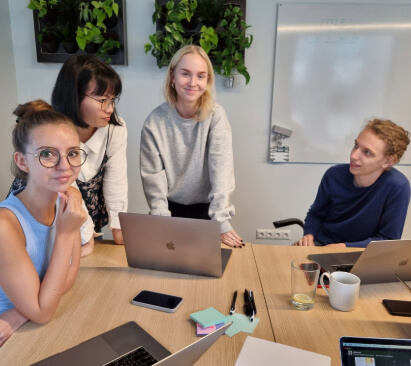Careers in Engineering
Help shape and build our product’s future.
The opportunity to impact millions
At Wise, we’re experiencing phenomenal growth. But scaling our users and volumes to reach millions more customers brings very real technical challenges. You’ll help us take Wise to the next level.
You’ll do more than simply support an existing system. If you’re keen to learn, grow, try new things and want to impact the way millions of people around the world work and live, read on.


A structure as unique as our people
We work cross-functionally in squads who are vital to driving the mission of our business forward. Teams are empowered to define their vision, priorities, and KPIs together.
You won’t be boxed in and will be free to work on our current and new products. We’ll help you to grow, and have the ability to shape our products — you’ll love to figure things out on your own.
You’re not afraid to roll up your sleeves and take responsibility across the full product lifecycle. You’re accountable and get things done.
Engineering roles
So, what are we focused on?

1
FRONT END
Along with being a keen self-starter, you’ll work closely with the Design team to create a product that gives the best possible experience to our customers.

2
BACK END AND FULL STACK
Go far beyond being ‘just an engineer.’ Use your wealth of technical skills to clearly and concisely articulate complex concepts to teams and help enhance customer experience.

3
PLATFORM
When things work, they should be invisible. Providing the backbone of the Wise experience, you’ll listen, adapt and evolve to enhance our platform.

4
MOBILE
Always on hand, our app keeps us super close to our customers. We’re in their back pocket everyday and you’ll help make the Wise app experience convenient, easy and fast for busy, on-the-go lives.

5
SECURITY
A pivotal team that has touch points throughout the company. From encryption and algorithms to identity service and authentications, your impact can be transformational to our customers.

6
ENGINEERING LEADS
Know the product, know the audience, know the tech, lead, coach, build the team and make difficult (and sometimes unpopular) decisions. Pack a few hats, you'll need them all.

7
I.T.
Adapt, analyse and advise. Keep the wheels of Wise well oiled and empower our teams with customer-driven, cost-efficient solutions.

Jobs you might be interested in
Salary
80000 - 125000 GBP Annual
Location
London
Team
Technology
Locations
London
Description
We are looking for an experienced Technical Presales Engineer who will play a crucial role in our sales and solution design processes.As the primary technical point-of-contact during the sales cycle,
Reference
664bce01-94c4-465a-ad85-9b2a9eaca37b
Expiry Date
01/01/0001
Salary
£80,000 - £102,000 + RSUs
Location
London
Team
Technology
Locations
London
Description
We are looking for a Senior Platform Engineer with passion and experience in cloud infrastructure, especially in GCP.Our team is responsible for building and maintaining the services that help ensure
Reference
b69912e5-e687-47b0-b3c7-fdf2b6f51bfe
Expiry Date
01/01/0001
Salary
£60,000 - £80,000 + RSUs
Location
London
Team
Technology
Locations
London
Description
We are looking for a Platform Engineer with passion and experience in cloud infrastructure.Our team is responsible for building and maintaining the services that help ensure Wise’s cloud infrastructur
Reference
a3c3b81a-94c3-417b-aa0d-be4d78096b7d
Expiry Date
01/01/0001
Salary
80000 - 115000 GBP Annual
Location
London
Team
Technology
Locations
London
Description
We operate on a strong belief in automation, programmatic implementation, and reusable design. We’re looking for people who can step back and think holistically about the ecosystem, but also follow th
Reference
b3452225-c056-4341-a35b-a5a5242ff072
Expiry Date
01/01/0001
Salary
$210,000 - 260,000
Location
Austin
Team
Technology
Locations
Austin
Description
Wise, one of the world's fastest-growing companies, is on a mission to redefine global finance by making money without borders the new norm.Current banking systems present challenges in seamlessly sen
Reference
46ee895b-dfa2-40bf-8fda-0f876672b5b3
Expiry Date
01/01/0001
Salary
£95,000-£130,000 + RSU
Location
London
Team
Technology
Locations
London
Description
About the role We are looking for an Engineering Lead with a strong interest in all aspects of cyber security.Our team is the Application Security Team, our mission is to protect Wise application code
Reference
5ebf0c0e-95d8-47d1-ba53-eca869da885a
Expiry Date
01/01/0001
Salary
S$165k - 240k + RSU's
Location
Singapore
Team
Technology
Locations
Singapore
Description
Solutions Engineering at Wise is a post sales role, focussed on working with our integrating partners to enable them to successfully launch a product based on Wise’s services. The role is multifaceted
Reference
35343b60-6c22-4382-81dd-d3908f3d20b6
Expiry Date
01/01/0001
Salary
-
Location
Austin
Team
Technology
Locations
Austin
Description
Software Engineer – NorthAm Wise Account $145,000-180,000 + RSU + Benefits Wise, one of the world's fastest-growing companies, is on a mission to redefine global finance by making money without bord
Reference
5cdc4d00-fdda-409a-ac49-eec2891f32e4
Expiry Date
01/01/0001
Salary
-
Location
Austin
Team
Technology
Locations
Austin
Description
Senior Engineer - Backend $170,000-260,000 + RSU + Benefits Wise is one of the fastest growing Fintechs in the world and we’re on a mission to make money without borders the new normal. We’ve got 16 m
Reference
211de841-00f6-40e2-9800-c38518ba8844
Expiry Date
01/01/0001
Related blogs
.jpg)
Teaser
Our workContent Type
BlogPublish date
11/16/2023
Summary
Why I joined Wise I joined Wise as a graduate engineer right after finishing university. One question I’m frequently asked is why I chose Wise to start my career. A few things a

Teaser
People profileContent Type
BlogPublish date
10/11/2023
Summary
My name is Ali Salman, I’m a last year computer engineering student at Budapest University of Technology and Economics. This summer, I was an engineering intern at Wise in Budapest for 10
.jpg)
Teaser
People profileContent Type
BlogPublish date
05/30/2023
Summary
Hi there! 👋 I’m Stella, a Software Engineer based in Budapest, Hungary. I joined Wise back in September 2022 and I’d love to walk you through how I became passionate about softwar
.png)
Teaser
People profileContent Type
BlogPublish date
04/18/2023
Summary
I’m Holden and I’m a Software Engineer on the Contact Handling team. In my team, we build tools to support our Support. What that boils down to is making sure our c
.jpg)
Teaser
People profileContent Type
BlogPublish date
03/31/2023
Summary
A bit about me Hey 👋🏽 I’m Jasleen and I’ve been here at Wise as a graduate software engineer since September. You may also remember me from a year ago too as I was also an int

Teaser
Our workContent Type
BlogPublish date
02/01/2023
Summary
Solutions engineering is both the most accurate and most problematic job title I’ve ever had.It describes exactly what my team and I do at Wise, which is great, but it can also be inte
